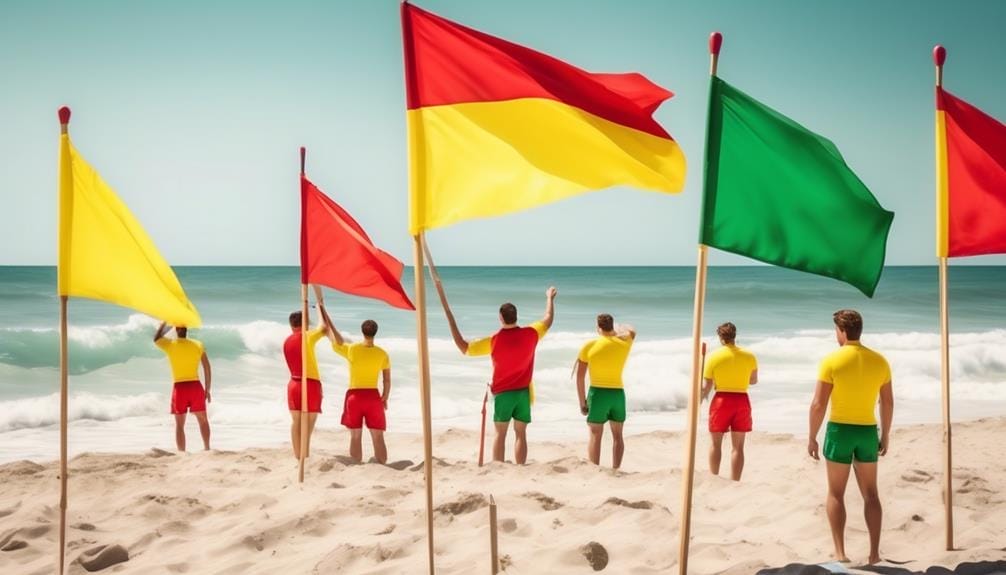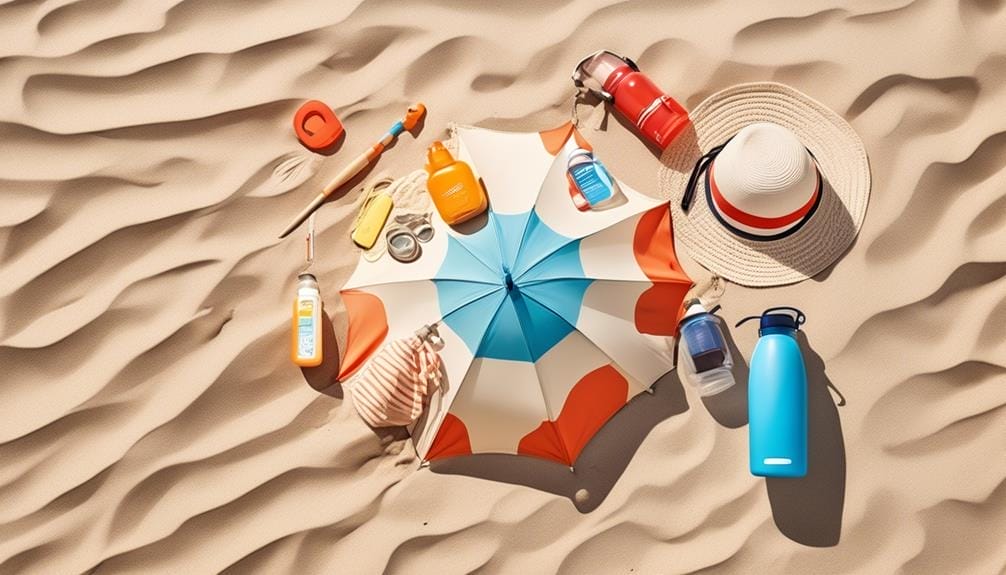Imagine stepping onto the sandy shores of 30A, the sun casting its golden glow upon the turquoise waves.
But wait! Before you dive headfirst into the mesmerizing waters, there are a few guidelines to keep in mind to ensure a safe and enjoyable beach experience.
From the importance of swimming in designated areas to understanding the subtle signs of rip currents, these guidelines will equip you with the knowledge and precautions necessary to navigate the beautiful yet unpredictable coastal environment.
So, let’s explore these 30A Beach Safety Guidelines together and discover the secrets to a worry-free day by the sea.
Key Takeaways
- Familiarize yourself with beach safety tips and be aware of potential dangers.
- Use sunscreen with SPF 30 or higher and reapply every 2 hours
- Stay at least 100 feet away from piers and jetties and be cautious of rip currents
- Always swim in designated areas with lifeguards, and never swim alone
Importance of Beach Safety
Beach safety is of paramount importance for everyone, regardless of their swimming abilities or experience. Whether you’re a seasoned swimmer or just dipping your toes in the water, it’s crucial to be aware of potential dangers and take the necessary precautions to ensure your safety.
To start, familiarize yourself with beach safety tips. These simple guidelines can go a long way in preventing accidents and injuries.
Additionally, always be mindful of water conditions, as they can change rapidly. Keep an eye out for rip currents, which are strong, fast-moving currents that can quickly pull swimmers away from shore. If caught in a rip, it’s important to stay calm and swim parallel to the shore until you’re out of the current.
Consider taking swim lessons to improve your water competency and safety awareness. Not only will this increase your confidence in the water, but it will also teach you valuable skills for injury prevention.
Remember, lifeguards are trained professionals who are there to help keep you safe. Listen to their advice and follow any warnings or instructions they provide.
Sun Protection Tips
To protect yourself from the sun’s harmful rays, it’s essential to follow these sun protection tips:
- Use sunscreen with SPF 30 or higher: Applying sunscreen is crucial to shield your skin from the damaging effects of UV rays. Look for a broad-spectrum sunscreen with a sun protection factor (SPF) of 30 or higher to ensure maximum protection.
- Reapply sunscreen every 2 hours: Whether you’re swimming or sweating, it’s important to reapply sunscreen every two hours. This will maintain its effectiveness and provide continuous protection.
- Wear protective clothing, hats, and sunglasses: Covering up is another effective way to safeguard yourself against the sun. Wear lightweight, long-sleeved shirts, wide-brimmed hats, and sunglasses with UV protection to minimize exposure.
- Seek shade during peak sun hours: The sun’s rays are strongest between 10 am and 4 pm. To reduce your sun exposure, find shade during these hours. It can be a beach umbrella, a tree, or a covered area nearby.
Understanding Rip Currents

When heading to the beach, it’s crucial to understand the potential dangers associated with rip currents. Rip currents can form in any large open water area, such as the ocean or Great Lakes. Before entering the water, always check conditions and ask a lifeguard about potential hazards. It’s important to stay at least 100 feet away from piers and jetties, as these are common locations for rip currents to occur.
If you find yourself caught in a rip current, it’s essential to stay calm. Don’t panic. Remember that rip currents can pull you away from the shore, so it’s crucial not to exhaust yourself by trying to swim directly against the current. Instead, swim parallel to the shore to escape its pull. If you’re unable to escape, draw attention to yourself and call for help. Lifeguards are trained to assist in these situations and can provide the necessary help.
Always be aware and cautious of changing tides, fast-moving currents, and drop-offs, as these can contribute to the formation of rip currents. By staying informed and following these safety guidelines, you can ensure a safe and enjoyable time at the beach.
Swimming Safety Guidelines
For a safe and enjoyable swimming experience, it’s crucial to follow these swimming safety guidelines:
- Always swim in designated areas with lifeguards: These areas are carefully monitored, ensuring your safety and providing immediate assistance if needed.
- Never swim alone and always have a swimming partner: Having someone with you increases safety and can help in case of emergencies.
- Be aware of rip currents and dangerous conditions before swimming: Educate yourself about the signs of rip currents and dangerous conditions, and avoid swimming in those areas.
- Follow lifeguard instructions for a safe swimming experience: Lifeguards are trained professionals who know the beach conditions and can guide you to ensure your safety.
By adhering to these guidelines, you can make sure your swimming experience is safe and enjoyable. Remember to always swim in a designated area with lifeguards, never swim alone, and be aware of rip currents and dangerous conditions. It’s also important to follow the instructions of lifeguards, as they’re there to keep you safe. By taking these precautions, you can have a great time in the water while minimizing the risks associated with swimming.
In addition to these guidelines, it’s important to take swim classes and learn about water safety. This will provide you with a better understanding and preparation for any swimming situation.
Lastly, remember to drink plenty of water to stay hydrated and to wear layers of protection such as sunscreen and a hat to protect yourself from the sun’s harmful rays.
Beach Flag Meanings

The meanings of beach flags indicate the current conditions and hazards present at the beach. It’s essential to keep an eye on these flags to ensure your safety and the safety of your loved ones.
When you see a double red flag, it means that the water is closed to the public. This flag indicates a high level of danger, and you should never attempt to reach the water. Strong currents or hazardous conditions may be present, making it unsafe for swimming.
A single red flag signifies high hazards, such as strong surf or currents. While it isn’t prohibited to enter the water, exercise caution and be aware of the potential risks.
A yellow flag indicates a medium hazard level with moderate surf or currents. It’s still important to be cautious and mindful of the conditions.
A green flag signals low hazards and calm conditions. However, it’s always wise to stay alert and follow any instructions provided by lifeguards.
Finally, a purple flag warns of dangerous marine life, usually jellyfish. If you come across this flag, be cautious and avoid swimming in those areas.
Safety Tips for Children at the Beach
To ensure the safety of children at the beach, it’s crucial to follow these essential guidelines:
- Always supervise young children closely when they’re near the water. Accidents can happen in an instant, and it’s important to keep a constant eye on them.
- Teach children to stay away from structures such as piers, jetties, and rocks. These can be dangerous areas with strong currents and sharp edges.
- Make sure children know how to swim and are comfortable in the water. If they aren’t strong swimmers, have them wear a life jacket for added safety.
- Encourage children to ask a lifeguard for help if they’re unsure about entering the water or if they need assistance while swimming. Lifeguards are trained to respond to emergencies and can provide valuable guidance.
Essential Items for a Safe Beach Day

When preparing for a safe day at the beach, it is essential to gather the necessary items to ensure your well-being and enjoyment. Having the right items with you can make a big difference in keeping you safe and comfortable throughout the day. Here are some essential items that you should consider bringing:
| Essential Items | Reason |
|---|---|
| Sunscreen with SPF 30 or higher | Protects your skin from harmful UV rays and reduces the risk of sunburn. |
| Plenty of water | Staying hydrated is crucial, especially on hot days, to prevent overheating and dehydration. |
| Lifeguarded areas | Swimming in designated lifeguarded areas ensures safety and assists in case of emergencies. |
| Beach umbrella or tent | It provides shade and protection from the sun, reducing the risk of heatstroke and sunburn. |
| First aid kit | Allows you to handle minor injuries and illnesses quickly and easily, ensuring prompt care when needed. |
Frequently Asked Questions
What Are the Safety Rules for the Beach?
You should always follow the beach flag system, be aware of rip currents, take sun protection measures, be cautious of water depth, wear proper beach attire, use beach equipment safely, supervise children, and know first aid and emergency procedures.
What Are the Basic Beach Safety?
You want to know the basic beach safety. Remember to wear sunscreen for protection, be aware of rip currents, take precautions in water depth, understand beach flag meanings, practice safe swimming techniques, handle beach equipment safely, prepare for wildlife encounters, and have first aid essentials.
What Are the Safety Reminders for the Beach?
Remember to be aware of beach hazards such as rip currents and wildlife. Stay safe by following the beach flag system, using sun protection, and having the necessary beach equipment. Know basic first aid for any emergencies.
What Should I Be Careful of at the Beach?
Be careful at the beach for rip currents, jellyfish stings, sunburn, water pollution, dangerous marine life, and heatstroke. Look out for beach flags and use appropriate safety equipment to stay safe.
Conclusion
As the sun sets on another beautiful day at the beach, it’s crucial to reflect on the importance of beach safety. Remember, the ocean can be unpredictable, and the key to a safe experience is being prepared and informed.
By following the 30A Beach Safety Guidelines, you can ensure a day filled with fun and relaxation.
So, next time you head to the beach, keep these tips in mind and create unforgettable memories while staying safe.





